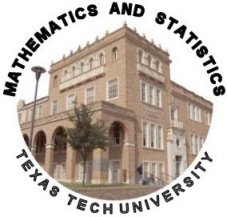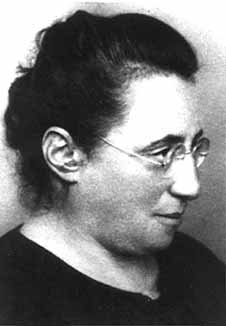
Texas Tech University, Department of Mathematics and Statistics
May 9th 2007

|
5th Emmy Noether High School Mathematics Day
Texas Tech University, Department of Mathematics and Statistics May 9th 2007 |
|
Workshops for Students
E. Aulisa and P. Seshaiyer "Mathematical Modeling of Problems in Science and Engineering" The workshop is intended to serve as an introduction to mathematical Modeling of problems arising in science and engineering. In this session, the Students will actively learn to develop ability to mathematically formulate problems from a nonmathematical description; identify features relevant to a model and be able to analyze the model using analytical techniques; and perform computations using state-of-the-art mathematical software. The topic introduced will enhance the learning of participants in problem-solving and open-ended exploration in mathematics classrooms.The viewpoint will be modern, with connections made between each topic and a variety of applications arising in science and engineering. By the end of the session, the student should not only be familiar, but be more confident, in mathematical modeling and computational mathematics. J. Dwyer "Mathematical Games for All Ages" Several mathematical games will be presented. These involve both visual and abstract thinking. Some are based on geometry and others on number patterns. Deductive reasoning is exhibited and the relevance of games to problem solving in the middle school math curriculum is explained. In addition, participants will have an opportunity to outwit the professor in these games! P. Hadjicostas "Fermat Primes" A prime number is an integer that is divisible only by one and itself. A Fermat prime is a prime number of a special form, introduced by the French mathematician Pierre de Fermat in the 17th century. There are only five known Fermat prime numbers, but we do not know how many there are altogether. In this presentation, we will talk how Fermat primes are related to Geometry, and especially the construction of regular polygons by ruler and compass. C. Monico "Geometry of Solids" Some surprising and unexpected things happen when we do geometry in 3 dimensions instead of 2. In this talk, we will look at one such surprising result which has been known since antiquity (in fact, it is in the last book of Euclid's Elements). A regular polygon is one which has: (1) all edges are congruent, (2) all angles are congruent. For example, equilateral triangles, squares, regular pentagons, regular hexagons, regular heptagons,... are all regular polygons. Consider the corresponding notion for 3 dimensional shapes (for example, think of a cube). This requires careful thought: whereas the sides of a polygon are edges (just line segments), the sides of a polyhedron are polygons. We have to be careful about how to define regular polyhedra: we would like (1) faces which are congruent regular polygons, (2) each vertex touches the same number of faces. For example, in the case of a cube, the faces are congruent squares and each vertex touches exactly 3 faces. What we will see is that although there are infinitely many regular polygons (2-dimensional), there are only 5 regular polyhedra! (Collectively, they are called the Platonic solids). L.-I. Roeger "Let's have fun with paper plates" Paper plates are not for picnic only. You can have fun with them too. I will show you how to form a pyramid using only one paper plate. Spheres can be made using four paper plates and a few hair clips or scotch tapes. Students who attend this workshop will also put together a fancy sphere formed by 20 paper plates. No advanced math skills are needed in this workshop. You just need to have an open mind and great imagination. Come and have fun. M. Strauss "On Infinity" Large numbers have been of interest throughout the history of civilization. Many interesting things have been "discovered" by the use and misuse and even abuse of infinity. We will talk about some of these. B. Williams "Circles: Enough to go around" We'll explore the amazing properties of circle packings. From simple geometry to complex functions, we'll see how circle packings can give us insight into electrical networks, create maps of our brains, and even help computers recognize faces. |
 |
|
Workshops for Teachers
C. Seaquist "A Cultural and Historical Dimension to Long Division" We examine two algorithms for performing long division: one that will be known to most American teachers and another that will be more familiar to French, Latin American, or Spanish teachers. We show that each of these, as well as, a third method that was popular in the late Middle Ages and Renaissance, are based on three different algorithms for performing subtraction. In an attempt to find the origins of these different approaches we visit the earliest printed arithmetic books in this country and in Europe. J. Surles "Online Resources for Effectively Communicating Statistical Concepts" It's easy to tell students that the Central Limit Theorem works, that the Law of Large Numbers really is a law, or that Buffon's Needle really provides a method for estimating pi. It's quite another to actually show the students. If you were to demonstrate any of these without a computer, you would be required to collect large numbers of samples of data which is, to say the least, difficult to do in a classroom setting. That's where computers come in. There are many free tools scattered all throughout the Internet that can make a teacher's job much easier by helping them to explain concepts that are sometimes difficult to grasp. They allow students to "see" these concepts in action, usually through simulation. Sometimes, they are able to interact with them by setting up certain aspects of the simulation themselves. Because most of them are written in Javascript, more enterprising can even "pick them apart" to see if the simulation is "cheating" or not. I will demonstrate many of these during the workshop, as well as highlight other statistical analysis tools that are available free or nearly free. |
 |